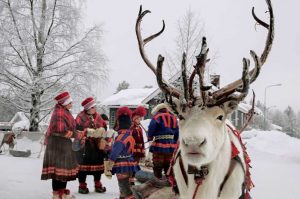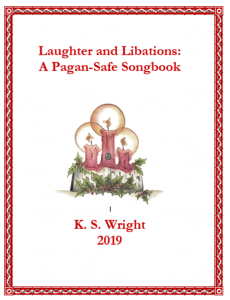Of all my favorite holidays, Christmas isn’t.
All the other December holidays come and go peacefully. Unfortunately, there is something about Christmas that just brings out the worst in Christians. The simple action of wishing someone “Happy holidays” has them frothing at the mouth. They seem to have forgotten that “Seasons greetings,” “Happy holidays,” and “Merry Xmas” have been in circulation over 100 years.

Instead of demonstrating peace on Earth and goodwill toward men, Christians go around insisting everyone has declared war on Christmas. That simply isn’t true. No one has declared war on Christmas. (At least not since 1659, when the Puritans banned it.) Christmas has declared war everyone else.
December is a busy month. A short list of religions holidays, ardently ignored by Christians, includes: Bodhi Day, Jamhuri Day, Saturnalia, Yule, Midwinter, Dongzhi Festival, Hanukkah, Human Light, Festivus, Kawanzaa, and Incwala Day. Many of these holidays, like Bodhi Day (originating in 596 BCE) predate Christianity by hundreds of years. December is also home to a host of national, international, and secular holidays. Some examples are:
- Pearl Harbor Day, December 7th
- The Festival of Enormous Changes at the Last Minute, December 30th
- Weary Willie Day, December 9th. (My best guess is, this one celebrates men with perpetually limp dicks.)
Christianity and Paganism
Incidentally, December 25th is also the date of Sol Invictus, a celebration to honor the Roman Sun God.
Many of the early Christians’ targets for conversion were polytheists. They were often dismayed to find their converts still celebrating Saturnalia and other holidays, even after having been baptized. It seems that the pagan converts simply added Jesus to the list of entities they worshiped, not exchanged him for all the rest. Consequently, Christians ended up holding “Christ Masses” after the pagan festivities had ended so their converts could confess, repent, and try again.
The Roman Emperor Aurelian established the cult of Sol Invictus as an official religion alongside the traditional Roman cults in 274 CE. In the article, “How December 25 became Christmas“ Andrew McGowan of the Biblical Archeological Society claims the date was deliberately chosen to thwart early Christian attempts at converting Roman citizens. Aurelian figured that by placing another holiday directly on top of the “Christ Masses” the citizens would choose the party over repentance. Using a savvy bit of marketing, Pope Julius I stabbed back at Sol Invictus’s cult by recasting the “Christ Masses” and claiming December 25th was not the birth of THE SUN, but the birth of THE SON.
That was a blatant falsehood and everyone knew it. One need look no further than the gospels to see that the shepherds were in the field watching their flocks by night, not inside warming their backsides by the fire. That’s a pretty clear indication that Jesus wasn’t born in the winter, a fact that was already well documented. In 200 CE Clement of Alexandria wrote, “There are those who have determined not only the year of our Lord’s birth, but also the day and they say that it took place in the 28th year of Augustus, and in the 25th day of Pachon (May 20 in our calendar). … Further, others say that He was born on the 24th or 25th of Pharmuthi (April 20 or 21).” (Stromateis 1.21.145)
Regardless, Pope Julius I oversaw the first official “Christmas” on December 25, 336 CE and incorporated elements of Saturnalia, a holiday that had been celebrated for 800 years at that point. In 217 BCE, Cato the Elder bemoaned the addition of Greek customs to the Roman Saturnalia holy day. Prior to 217 BCE, they celebrated according to Roman custom. Afterwards, public banquets and continual shouts of io Saturnalia were added. Doubtless, Cato would have been mortified to see Christianity overlaid.
It wasn’t until the 6th century that Christians began encountering and attempting to convert Germanic populations. As a result, Yuletide traditions got added to the already sloppy mix.
 As it happens, Santa is an amalgamation of three Pagan characters:
As it happens, Santa is an amalgamation of three Pagan characters:
- Julnik (Yule-Nick) is one of the names Odin travels under when in disguise. Like Santa, Odin has a long white beard. He also dresses in fur, as is befitting the northern climate. In the month of Jule (Yule/December) he visits his followers in secret, listening around their fires to see if they are content.
- In Lapland, bell-wearing shamen, dressed in red and blue, travel via reindeer and sleigh.
- Holland gives us Sinterklass, who has a long white beard, a magical red cloak, and rides across the wind-whipped, winter skies on a white horse, filling the shoes of good children with gifts.
When it comes to evergreens, Yule logs, and greenery, those weren’t even permitted inside most churches until the 1850s.
Jeremiah 10:1-10 essentially reads:
Do not go into the forest, cut down a tree, lug it home, set it up in the living room, and decorate it. The heathens do that at the time of the winter solstice and it’s bad.
But it’s not like Christians spend much time reading their bibles. Or even agree about what’s contained therein. The Puritan movement of the 16th and 17th centuries objected to ornamentation and ritual in church, insisting it was a form of idolatry. Even more strict than reformationists, Puritan separatists abandoned the Anglican Church of England and established a colony at Plymouth, Massachusetts in 1620, where they regularly persecuted other faiths.
The Pilgrams who arrived in the Americas sought purge themselves of all things Catholic. In 1647, Massachusetts passed a law prohibiting Catholics from entering any territory under Puritan jurisdiction. Those unable to prove their Puritanism were banished from the colony—anyone who returned to the colonies after being banished was executed. The punishment for being Quaker was hanging. And there were, quite literally, witch hunts.
In 1659, the General Court of Massachusetts Bay Colony passed a law prohibiting Christmas celebrations. Anyone caught in the act of celebration, by feasting, closing their shops, not working, or by any other means, was fined five shillings. The 1st United States Congress assembled in 1789 and Congress was in session on Christmas Day. It wasn’t until 1855 that congress began to go into recess over the holidays. In fact, Christmas did not become a national holiday in the United States until 1870. That was thanks in large part to the Merchant’s Lobby. Bolstered by the lucrativeness of the recently created Thanksgiving holiday, they sought another reason to compel people to purchase their wares.
So, who’s winning the war on Christmas? Corporations and the Merchant’s Lobby, that’s who.
Any religion that advocates for spending time with family rather than amassing huge amounts of consumer debt is being systematically squeezed out. Fiscal responsibility has become unpatriotic. Domestic responsibility and contentedness have become sacrilegious.
Christians and Pagans alike have been jockeying for position, combining and re-combing holy days, and alternately adopting and shunning each other’s traditions, from the beginning. All this makes me wonder why everyone can’t just drink and be merry?
 Rather than feed corporate greed, I advocate for the consumption of liquor and the spreading of merriment during December. To this end, I have created my annual version of Laughter and Libations.
Rather than feed corporate greed, I advocate for the consumption of liquor and the spreading of merriment during December. To this end, I have created my annual version of Laughter and Libations.
Many traditional carols have pagan origins. Other songs, now co-opted as Christmas songs, make no mention of Christmas: Walking in the Winter Wonderland (1978), Suzy Snowflake (1951), Let it Snow (1945), etc. Heck, Jingle Bells (1857) was originally a drinking song! Songs whose sole purpose is celebrating Christmas are easily rewritten. After all, we’ve been co-opting each other’s traditions for hundreds of years; turnabout is fair play.
In addition to the history and frivolity surrounding the songs, Laughter and Libations includes a number of liquor infused recipes. There’s nothing like spirits to raise your spirits!
In addition to drinking and being merry, those wanting a Pagan connection to the holidays might try Yule-Logging. One birch or aspen tree can easily provide enough yule logs for 8 to 10 families.

Gather a group of friends and head to the forest. Look for a tree with a 6” diameter at about chest height. There’s no need for chainsaws, an ax and handsaw will do the trick. After the tree is felled, each family can saw of their own 16” segment. Once decorated, they can be displayed as the centerpiece for holiday gatherings.
While you’re in the woods, remember to take the time to gather enough greenery to decorate your log and make wreaths or swags. When the holidays are over, be sure to burn your Yule Log to bring good luck in the coming year.
The associations for plants commonly used in creating Yule Logs is listed below:
Aspen—Protection and healing. Having aspen on your property is thought to protect from thieves. Also, the buds, bark, and leaves contain a compound similar to aspirin. This healing tree offers a sense of perseverance and helps you through hard times.
Birch—rebirth and new beginnings. Often called the “Lady of the woods,” birch contains feminine energy and is thought to protect against infertility. At the time of the winter solstice it symbolizes the rebirth of the sun.
Fir*—protection. Hanging fir branches over your bed is said to prevent nightmares, while hanging branches over the barn door keeps stock and grain stores safe from thieves.
Holly—protection, foresight, and goodwill. The Druids incorporated holly into their Midwinter rites because it stayed green all year, providing a promise of the spring to come. It carries masculine energy, often denoted as the Holly King.
Ivy—protection, fidelity, and fertility. It carries feminine energy, often denoted as the Ivy Queen. For centuries this plant was banned from Christian celebrations, fearing that if it was displayed, unrestrained feasting and drunkenness would ensue.
Mistletoe—fertility. The Celts thought the white berries resembled semen, an indication of the plant’s virile powers. In Scandinavian countries, the pant was so sacred that if enemies happened to meet where the plat was growing, they were required to lay down their weapons and declare a truce for the remainder of the day. This is where the custom of hanging mistletoe in a originated, requiring all who enter to pledge peace and friendship, sealed with a kiss. Mistletoe is toxic, so make sure to keep it out of reach of children and pets.
Pine*—immortality and rebirth. One of the earliest forms of Yule Logs, the Druids burned pine logs during Mid-Winter to lure the sun back to earth. Placing pine boughs over your door wards off negativity and illness while promoting prosperity for the household.
Spruce*—protection. The Scandinavians call it “the tree of life.” (I call it a “prickly pain-in-the-ass,” but if you have pets or toddlers, this is a good choice if you want a Christmas tree.)
*Pine, spruce, and fir are considered the seat of the gods. These trees are guardians of the forest and by bringing them into your home, the protection magic associated with them is transferred to your family. Combined, they create a fresh and fragrant incense that conjures images of the forest.
